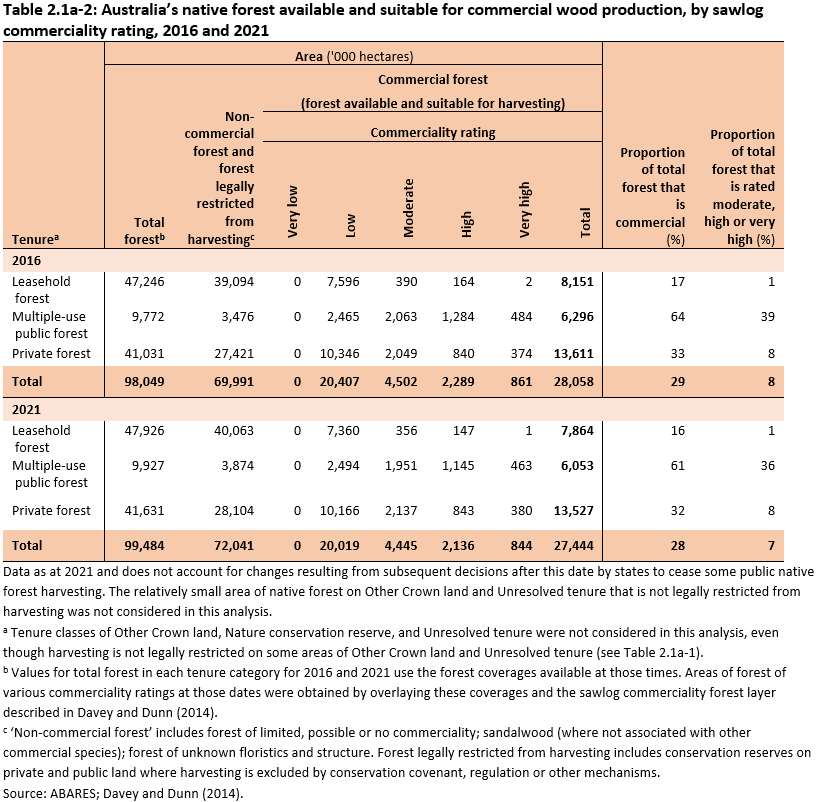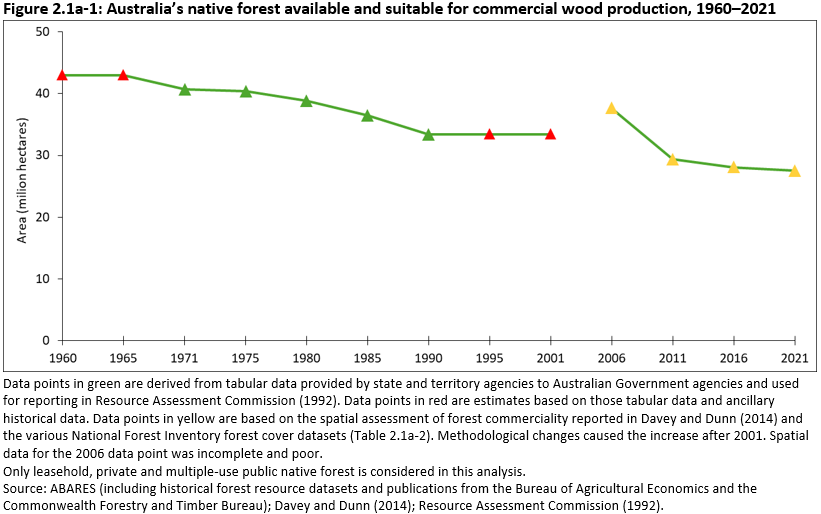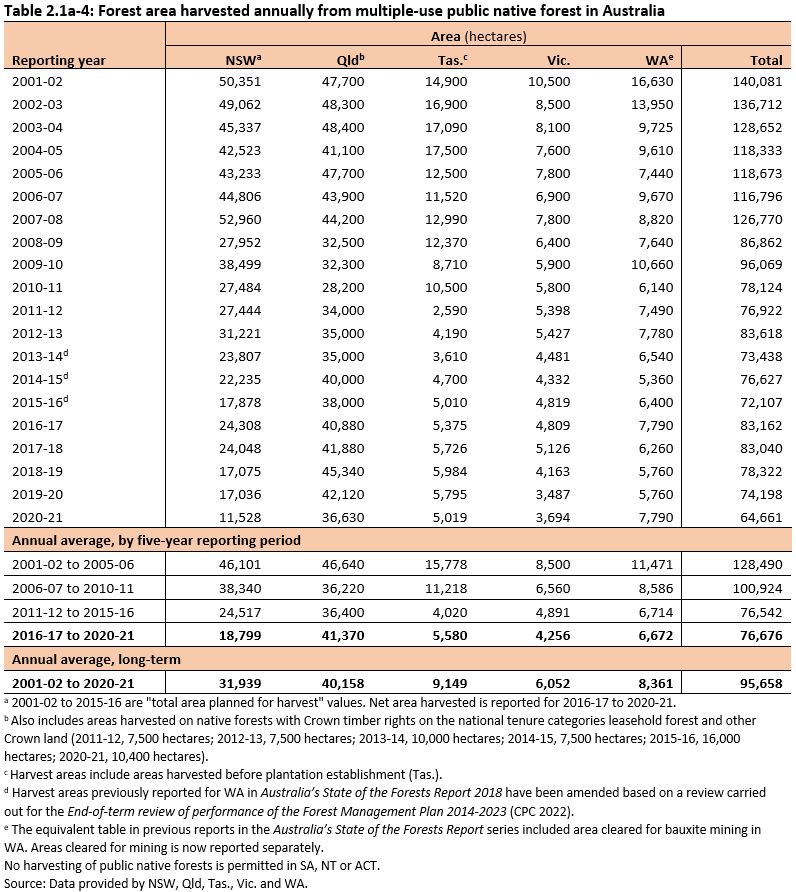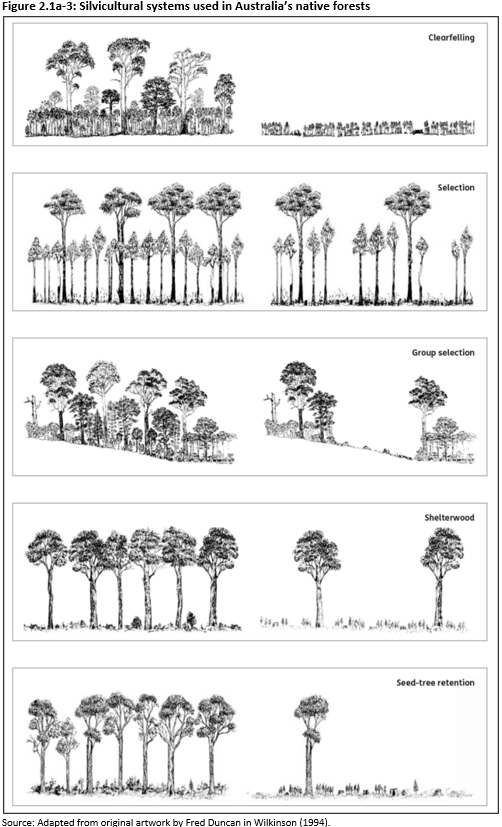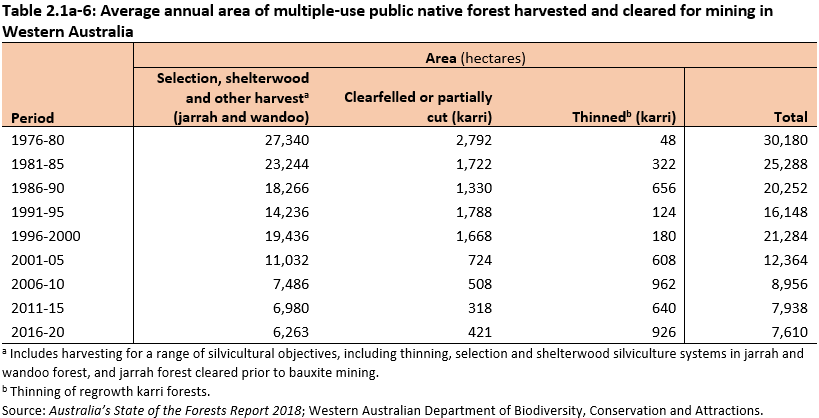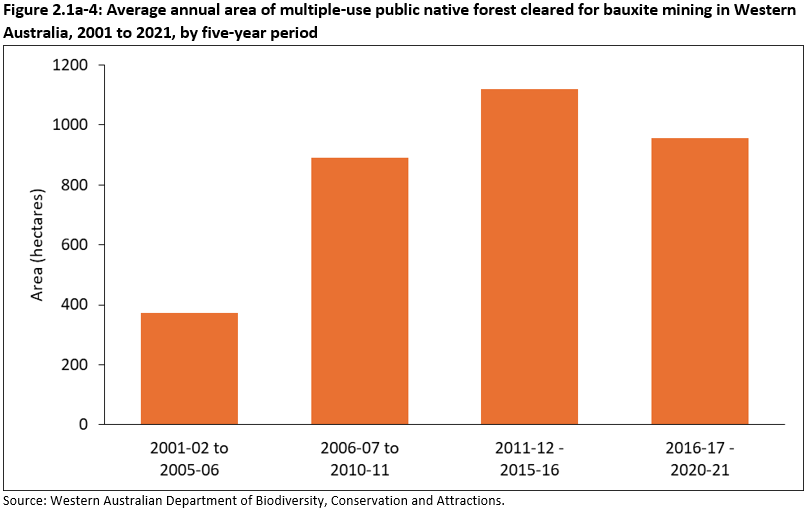This indicator reports the capacity of forests to sustainably produce wood to meet society’s needs into the future. The area of native forest available for wood production, the nature of the growing stock, and the area harvested over time provide means to demonstrate the sustainability of forest management.
This is Key information for Indicator 2.1a, published October 2024.
- The major source of Australia’s native wood and wood-based products has been multiple-use public forests in New South Wales, Queensland, Tasmania, Victoria and Western Australia; forests on land with leasehold and private tenure also contribute to supply in some states.
- The area of native forest not legally restricted from commercial wood harvesting was 81.3 million hectares in 2021, a decrease of 3% from the 83.6 million hectares reported in 2016.
- The area of native forest on leasehold, private and multiple-use public forest tenures available and suitable for commercial wood production was 27.4 million hectares in 2021, a decrease of 2% from the 28.1 million hectares reported in 2016.
- The net area available and suitable for commercial wood production in multiple-use public native forests (the net harvestable area) was 4.3 million hectares in 2020-21, a decrease of 14% from the 5.0 million hectares reported in 2015-16.
- Over the period 2016-17 to 2020-21, the average annual area of multiple-use public native forests from which wood was harvested was 77 thousand hectares, unchanged from the period 2011-12 to 2015-16. Within this area, most (86%) was harvested using selection silvicultural systems. The proportion harvested by clearfelling systems was 9%.
The native forest area available for wood production is reported as the area in which harvesting is not legally restricted.
Commercial wood harvesting is legally restricted on:
- nature conservation reserve tenure
- informal reserves on all other tenure (see Indicator 1.1c)
- private and leasehold forest that is under conservation covenant or reserved by other mechanisms
- other Crown land where harvesting is inferred to be legally restricted by government policy
- all native forest in South Australia and the Australian Capital Territory.
A total of 81.3 million hectares of Australia’s native forest was not legally restricted from wood harvesting in 2021, which is 62% of Australia’s total area of native forest (Table 2.1a-1). Within this area, regulatory prescriptions and exclusions substantially reduce the area from which wood can be legally harvested. This is discussed further below.
Queensland has the largest area of native forest not legally restricted from harvesting (41.9 million hectares), comprising mostly leasehold and private forest. This is followed by the Northern Territory and New South Wales, with 15.3 million hectares and 12.6 million hectares respectively.
The total area of multiple-use public native forest not legally restricted from harvesting is 7.8 million hectares. Most native forest wood harvesting in Australia occurs on this tenure class.
Click here for a Microsoft Excel workbook of the data for Table 2.1a-1.
Since 2016, the total area of native forest not legally restricted from wood harvesting decreased from 83.6 million hectares to 81.3 million hectares (a 3% decrease). This decrease is a continuation of the trend of decreasing area legally available for harvest since reporting began in 1998. For example, in Victoria between 2016 and 2021, the area of multiple-use public native forest where wood harvesting was legally restricted increased by 0.43 million hectares, in large part due to new harvest exclusion zones for old growth forest, greater glider (Petauroides volans) and Leadbeater’s possum (Gymnobelideus leadbeateri) (D’Ambrosio, Minister for Energy, Environment and Climate Change 2019). Forests across all tenures, but particularly multiple-use public native forests, are increasingly managed for a wider range of non-wood values, which further reduces area available for harvest.
A range of other legal considerations influence the availability of forest for wood harvesting. In New South Wales, wood harvesting from native forest on some other Crown land tenures may be allowed under the Crown Land Management Act 2016 subject to approval by the relevant Minister. However, since approval is not assured these areas are treated as legally restricted from harvesting until approval is given.
In Queensland, the area available for wood production by the state (the Crown) comprises all State Forest and Timber Reserves, large areas of other Crown land (including leasehold land, Forest Entitlement Areas and unallocated state-owned land) and some freehold land over which the state retains ownership of forest products.
In Tasmania, 0.36 million hectares of native forest were designated as Future Potential Production Forest (FPPF) land under the Forestry (Rebuilding the Forest Industry) Act 2014. On this land, special-species timber harvesting may be undertaken subject to relevant approvals. FPPF land may also be converted to Permanent Timber Production Zone (PTPZ) land upon application and approval by the relevant Minister. As at 2023, no special-species timber harvesting had occurred on FPPF land and none had been converted to PTPZ land. Therefore, for this analysis, FPPF land is classified as other Crown land and treated as legally restricted from harvesting.
In May 2023, the Victorian Government announced that commercial native timber harvesting on state forests would end by 01 January 2024. Processes to determine the future use and management of these areas are underway.
In September 2021, the Western Australian Government announced the end of commercial wood harvesting from southwest public native forests from 01 January 2024. Legislative changes have been introduced to restrict the salvage and removal of forest products to only areas cleared ahead of mining and infrastructure development, and to activities consistent with a conservation purpose, such as ecological thinning. Further, the Forest Management Plan 2024-2033 provides for an additional 400 thousand hectares of multiple-use public forest to be transferred to nature conservation reserve tenure.
The reported area of native forest not legally restricted from wood harvesting substantially overestimates the actual area available and suitable for wood production. This is because it includes forests that are not available for wood production because of jurisdictional regulations that apply to wood harvesting operations on these areas including codes of practice, management plans and requirements to manage forests for multiple values relating to biodiversity, heritage, recreation, and soil and water (see Indicator 7.1a and Indicator 7.1b), forest management intent, and local operational prescriptions and restrictions. Furthermore, there will be areas not commercially suitable for wood harvesting due to species and volume constraints, economic viability constraints and accessibility issues.
The use of a national sawlog commerciality database, previously assembled by ABARES using historical merchantability and productivity data, provides insight into the areas of multiple-use public native forest available and suitable for wood production. ‘Commerciality’ is determined by assessing the merchantability and productivity of forests for sawlogs (Davey and Dunn 2014).
As of 2021, there was an estimated 27.4 million hectares of native forest available and suitable for wood harvesting on leasehold, private and multiple-use public forest tenures, a decrease of 2% from the 28.1 million hectares reported in 2016 (Table 2.1a-2). The decline observed between 2016 and 2021 is part of a long-term decline (Figure 2.1a-1), which can be attributed to several factors including, changes in tenure (such as transfers of multiple-use public forests to nature conservation reserves), continuing increases in the area of multiple-use public native forest to which harvesting restrictions apply, and reclassification of forest to non-forest based on improved mapping techniques.
Click here for a Microsoft Excel workbook of the data for Table 2.1a-2.
Click here for a Microsoft Excel workbook of the data for Figure 2.1a-1.
Of Australia’s 27.4 million hectares of commercially suitable native forest, as at 2021 (Table 2.1a‑2):
- 6.1 million hectares (22%) is on multiple-use public forest tenure, which is 61% of the total 9.9 million hectares of multiple-use public native forest nationally
- 7.9 million (29%) hectares is on leasehold tenure (16% of total native forest on leasehold tenure)
- 13.5 million (49%) hectares is on private tenure (32% of total native forest on private tenure).
Of the 27.4 million hectares of commercially suitable native forest, 7.4 million hectares (27%) are of moderate, high or very high commerciality (Figure 2.1a-2):
- 3.6 million hectares (48%) occurs on multiple-use public forest tenure, concentrated in the higher rainfall parts of south-west, south-east and eastern Australia
- 3.4 million hectares (45%) occurs on private tenure
- 0.5 million ha (7%) occurs on leasehold tenure.
A large proportion (82%) of native forest on leasehold and private land available and suitable for commercial wood production has a low commerciality rating and contributes minimally to commercial wood supply. This is due to these forests generally being of low merchantability and productivity, isolated from existing markets, or located where harvesting is not operationally feasible or financially viable.
The ending of commercial harvesting in multiple-use public native forests in Victoria and Western Australia from 01 January 2024 is anticipated to reduce the total area available and suitable for commercial wood harvesting by 2.2 million hectares (or 8% of the national total) from the areas reported for 2021. Most (1.9 million hectares) of this area is rated as moderate, high or very high commerciality, which is 26% of the total moderate, high and very high commerciality native forest area across Australia. Victoria and Western Australia each account for 1.1 million hectares of the total reduction, of which 0.9 million hectares in Victoria and 1.0 million hectares in Western Australia is rated as moderate, high or very high commerciality. It is noted that the Western Australian Forest Management Plan 2024-2033 (CPC 2023) allows for the salvage, removal and sale of wood products arising from ecological thinning operations and clearing for mining, however, this is not considered in this analysis.
Net harvestable area is used as a basis to calculate sustainable yield from multiple-use public native forests. Net harvestable area is determined after subtracting the following areas from the total multiple-use public native forest area:
- areas within multiple-use forests that are reserved for the protection of values relating to biodiversity, heritage, recreation, visual amenity and soil and water and/or are zoned for management purposes that are not compatible with wood harvesting
- forest exclusion zones resulting from the application of conditions in codes of practice or other regulatory instruments (such as Integrated Forestry Operations Approvals in New South Wales)
- forests determined to have operational constraints, such as roading and extraction track access constraints, steepness or rockiness, or the occurrence of unacceptable safety risk
- forests determined to be unmerchantable, or unsuitable for wood production because of the age, size and species of trees, insufficient product volumes to cover production costs, or because trees have been damaged by fire or disease.
Only a proportion of the regulatory forest exclusion zones can be mapped in advance of forestry operations. Some prescriptions such as those relating to riparian zones, threatened fauna and flora, threatened ecological communities, Indigenous cultural heritage and other biophysical and cultural exclusions are applied as a result of field observations during preparation of a site for wood harvesting. This often results in actual harvested areas being less than the estimated net harvestable area for a discrete harvesting unit.
The estimated net harvestable area of multiple-use public native forest in Australia was 4.3 million hectares in 2020-21 (Table 2.1a-3), which was a decline of 0.71 million hectares (14%) from the area reported in 2015-16, and a decline of 5.8 million hectares (57%) from the 10.1 million hectares reported in 1995-96. The decline since 1995-96 includes reductions resulting from the implementation of Regional Forest Agreements that saw significant areas of multiple-use public native forest transferred to the conservation reserve system (Davidson et al. 2008). The net harvestable area of multiple-use public native forest was 10% of the total area of public native forest in Australia in 2020-21, compared to 22% in 1995-96.
Click here for a Microsoft Excel workbook of the data for Table 2.1a-3.
New South Wales
In New South Wales, the net harvestable area decreased by 53% from 2.4 million hectares in 1995-96 to 1.1 million hectares in 2020-21. However, net harvestable area increased slightly since 2015 16 from 1.0 million hectares to 1.1 million hectares in 2020-21. This increase is associated with significant changes made to the regulations applying to harvesting operations in New South Wales coastal multiple-use public native forests when the Coastal Integrated Forestry Operations Approvals commenced in 2018. Under these regulations, exclusion zone requirements for certain environmental features were modified, and a new condition was introduced requiring the identification and permanent protection of a proportion of the net harvestable area in ‘habitat clumps’.
In 2023, the New South Wales Government announced a process to establish a ‘Great Koala National Park’ on the state’s mid-north coast (DCCEEW 2023). During the park establishment planning phase, the government implemented a halt to timber harvesting in 8 thousand hectares of the state forest within the assessment area, with agreement from the state’s multiple-use public native forest management agency. The total park assessment area covers approximately 176 thousand hectares of multiple-use public native forest (DCCEEW 2024), much of which contains highly productive blackbutt (Eucalyptus pilularis) forest. This area remains as net harvestable area in Table 2.1a-3.
Queensland
In Queensland, the net harvestable area of multiple-use public native forest steadily decreased from 3.2 million hectares in 1995-96 to 1.4 million hectares in 2020-21 (a 57% reduction). The decrease observed between 2015 16 and 2020-21 (0.55 million hectares, or 29%) was due to improvements made to the process of delineating net area, rather than from any significant tenure changes.
In 2019, the Queensland Government announced the Native Timber Action Plan and committed to ending state-owned native timber production in the South East Queensland Regional Plan area on 31 December 2024, which includes 68 thousand hectares (gross) of multiple-use public native forest (Qld Government 2019).
In June 2024, the Queensland Government announced the Queensland Sustainable Timber Industry Framework which will be developed by mid-2025. Under the Framework, approximately 50 to 60 thousand hectares of high value ecosystems within the Eastern Hardwoods region and adjacent areas will transition to a new ‘Natural Capital Reserve’ (Qld DPC 2024). While the Framework is developed, harvesting permits for the Eastern Hardwoods region in areas not transitioning to Natural Capital Reserve, will be issued by the end of 2024 for a further two years to the end of 2026 (Qld Government 2024).
Tasmania
In Tasmania, the net harvestable area as at 2020-21 was 0.36 million hectares. This represents a 55% reduction in the net harvestable area since 1995-96 when the figure was 0.81 million hectares. Most of this reduction can be attributed to:
- the reallocation of areas of multiple-use public native forest to nature conservation reserves resulting from the implementation of the 1997 Regional Forest Agreement and the 2005 Tasmanian Community Forest Agreement (Davey 2018)
- successive changes to Tasmanian Forest Practices Code prescriptions in 2000, 2015 and 2020 (FPA 2022)
- the implementation of the 2013 Tasmanian Forest Agreement, including an extension to the Tasmanian Wilderness World Heritage Area (TWWHA) in 2013 (FPA 2012; FPA 2017). Note that the land earmarked for reservation in the TWHHA has since been re-classified as Future Potential Production Forest (FPPF) land, however, the area does not contribute to the net harvestable area figure reported in Table 2.1a-3.
Victoria
The net harvestable area of multiple-use public native forest in Victoria was 0.59 million hectares in 2020-21, a decrease of 29% from the 0.82 million hectares reported in 2015-16. This decrease was due primarily to additional exclusion zones for old growth forest, and protection for greater glider and Leadbeater’s possum. Since 1995-96, there has been a steady decline in net harvestable area from the 2.6 million hectares that was available at that time. Processes are underway to determine the future use and management of the reported net harvestable area after the ending of commercial wood harvesting in Victoria’s multiple-use public native forests from 01 January 2024.
Western Australia
The net harvestable area of multiple-use public native forest in southwest Western Australia was 0.85 million hectares in 2020-21, which was slightly more than area reported in 2015-16 (Table 2.1a-3). Since 1995-96, the net harvestable area decreased from 1.2 million hectares, representing a 27% reduction. This was a result of the transfer of parts of the state forests to nature conservation reserves and the introduction of a policy by the Western Australian Government to protect all old-growth forests.
In Western Australia, the ending of commercial wood harvesting from 01 January 2024 will also impact on net harvestable area, however, the Western Australian Forest Management Plan 2024-2033 (CPC 2023) allows for ecological thinning operations to occur within specified ‘Forest Enhancement Areas’. The primary objective of ecological thinning is to promote forest health and resilience, and conserve biodiversity by removing a proportion of trees to reduce competition for resources (primarily water, but also nutrients) on the retained trees (Burrows et al. 2022). Salvage, removal and sale of wood products arising from ecological thinning operations is permitted under the forest management plan.
The Western Australian Forest Management Plan 2024-2033 identifies approximately 134 thousand hectares of potential ecological thinning area in jarrah (Eucalyptus marginata), karri (E. diversicolor) and wandoo (E. wandoo) regrowth forests and mining rehabilitation. The actual area that will be thinned each year (up to 8,000 hectares in state forest and timber reserves is permitted) will depend on a range of factors including the comparative vulnerability to future forest health pressures and contractor capacity.
Net harvestable area on privately managed land
Definitive statistics of the net harvestable area of private or leasehold forests in any jurisdiction were not available. However, an estimated 0.36 million hectares of Victoria’s private and leasehold native forests were available and suitable for timber production in 2000-01 (DSE 2003), and more recent work by the New South Wales Department of Primary Industries identified 0.40 million hectares of potential net harvestable area in the private native forests of north-eastern NSW (NSW DPI 2019) and 0.08 million hectares of potential net harvestable area in the private native forests of southern NSW (NSW DPI 2024).
State agencies that manage Australia’s public forests for wood production report annually or five-yearly on the area of forest harvested and regenerated under various silvicultural (forest management) systems (Figure 2.1a-3). In contrast, limited data are available on the area of private native forests harvested in Australia, with only some data available for the area harvested in private forests of Tasmania and in leasehold forests of Queensland.
A total of 65 thousand hectares of multiple-use public native forest was harvested in 2020-21 (Table 2.1a-4), which represents 0.7% of Australia’s total area of multiple-use public native forest and 0.05% of Australia’s total native forest. This represents a 54% decrease from the 140 thousand hectares of multiple-use public native forest that was harvested in 2001-02. Many of the drivers for this decrease are described in the previous section by jurisdiction.
Between the periods 2011-12 to 2015-16 and 2016-17 to 2020-21 the average annual area harvested remained steady at 77 thousand hectares (Table 2.1a-4). This is despite reduced harvesting in Victoria, New South Wales and south-eastern Queensland in 2019-20 and 2020-21 when wood production was interrupted by the 2019-20 ‘Black Summer’ bushfires. For example, the harvested area in New South Wales dropped from an annual average of 21 thousand hectares for the four years from 2016-17 to 2019-20 to 12 thousand hectares in 2020-21 (44% decrease). In Queensland and Victoria, the decrease over the same periods were 14% and 16% respectively (Table 2.1a-4). The ‘Black Summer’ bushfires impacted large parts of the east coast and interrupted harvesting operations both directly (for example, approaching fire-fronts), and indirectly through impacts to harvesting schedules, threatened species concerns, increased safety risks and the reallocation of staff and machinery to assist with fire-fighting efforts. Forest harvesting machinery played a critical role in fire-fighting and post-fire environmental rehabilitation and recovery.
Click here for a Microsoft Excel workbook of the data for Table 2.1a-4.
In contrast to the trend observed in New South Wales, Queensland and Victoria, in Tasmania there was an increase in average annual harvest area since the 2010-11 to 2015-16 period (Table 2.1a-4). Between the periods 2011-12 to 2015-16 and 2016-17 to 2020-21, the average annual area harvested in Tasmania increased from 4.0 thousand hectares to 5.6 thousand hectares (a 28% increase). This was primarily due to a shift away from more intensive silvicultural systems (such as clearfelling and ‘intensive silviculture with retention’) towards selection harvesting and other less intensive systems that harvest from larger areas to yield the same wood volumes (see Figure 2.1a 3).
New South Wales and Queensland together contributed 78% of the multiple-use public native forest harvested in the period 2016-17 to 2020-21 (Table 2.1a-4). This high proportion was primarily due to the dominant use of selection silvicultural systems.
In Victoria, 540 hectares of multiple-use public native forest were subject to ‘fallen product recovery’ windthrow salvage operations during the period 2016-17 to 2020-21, primarily in the state’s west. These areas have not been included in the harvested area summaries provided in Tables 2.1a-4 and 2.1a-5.
The Forest Management Plan 2014-2023 for south-west Western Australia (CCWA 2013) discusses the sustainability of wood volumes and growing stock of jarrah, karri and wandoo forests, and Western Australia has a long history of reporting the annual area of forest harvested for wood and cleared for mining (Table 2.1a-6). The average annual area of jarrah, karri and wandoo forest types harvested for wood or cleared for mining decreased from 30,180 hectares in 1976-80 to 7,610 hectares in 2016-20, a 75% reduction. The majority of harvesting occurred using selection and shelterwood silvicultural systems (see Figure 2.1a 3).
Selection silvicultural systems are proportionally the most common systems used in the multiple-use public native forests of Australia and are practiced in New South Wales, Queensland, Tasmania, Victoria and Western Australia. Selection silvicultural systems include group/gap selection, single-tree selection (including light, medium and heavy selection systems and diameter limit cutting), native cypress pine silviculture (applied in New South Wales and Queensland), commercial thinning and mixtures of group selection and single tree selection. The specific selection system is chosen based on the growth stage and structure of the forest stand and the known regeneration responses of different forest types. Of the area of multiple-use public native forest harvested during the 2016-17 to 2020-21 period, 86% was carried out using selection silviculture systems. This compares to 87% during the preceding five-year period (2011-12 to 2015-16) (Table 2.1a-5).
Clearfelling is used as a silvicultural system to promote forest regeneration in Tasmania, Victoria and Western Australia in certain native forest types. Annual native forest clearfelling data presented in Table 2.1a-5 includes native forest regenerated to native forest and native forest converted to plantation between 2001-02 and 2010 11 (the conversion of native forest to plantation on public land in Tasmania was stopped in 2010). Salvage of fire-damaged native forests using clearfelling systems in Victoria and Tasmania, and areas clearfelled in association with bauxite mining in Western Australia are reported separately (Table 2.1a-5 and Figure 2.1a-4, respectively). Intensive silviculture with retention is also considered a clearfelling silvicultural system and includes areas harvested with seed-tree and/or habitat-tree retention and was practiced in Tasmania, Victoria, Western Australia and the Eden region of New South Wales during the 2016-17 to 2020-21 period. Of the area of multiple-use public native forest harvested during the period 2016-17 to 2020-21, 9% was carried out using clearfelling silvicultural systems. This proportion was also 9% during the preceding five-year period (2011-12 to 2015-16) (Table 2.1a-5).
Variable retention is a silvicultural system implemented in wet sclerophyll forests as an alternative to clearfelling systems. This silviculture has the explicit goal of maintaining habitat and structural features within the forest stand (Baker and Read 2011) to provide biodiversity benefits and satisfactory silvicultural outcomes (Scott et al. 2019). The use of this type of silviculture commenced in Tasmania in 2003 and in Victoria in 2013. Of the area of multiple-use public native forest harvested between 2016-17 and 2020-21, 1.3% was carried out using variable retention silviculture. This compares to 0.2% during the preceding five-year period (2011-12 to 2015-16) (Table 2.1a-5).
Shelterwood silvicultural systems are used for promoting and nurturing regeneration in specific forest types in Victoria and Western Australia. Of the area of multiple-use public native forest harvested between 2016-17 and 2020-21, 3.4% was carried out using shelterwood silviculture. This compares to 3.7% during the preceding five-year period (2011-12 to 2015-16) (Table 2.1a-5).
Click here for a Microsoft Excel workbook of the data for Table 2.1a-5.
Click here for a Microsoft Excel workbook of the data for Table 2.1a-6.
Bauxite mining has occurred within multiple-use public native forests south-east of Perth in Western Australia since the 1960s. While excavations associated with bauxite mining are relatively shallow, they are laterally extensive and involve the clearing of all vegetation and the removal and stockpiling of topsoil prior to mining and subsequent rehabilitation.
From 2001 to 2021, the total area of multiple-use public native forest cleared for bauxite mining in Western Australia was 16,630 hectares. During the 2016-17 to 2020-21 period, the average annual area of multiple-use public native forest cleared for bauxite mining was 956 hectares. This compares to an annual average of 1,118 hectares in the preceding five-year period (a 14% decrease). The total area cleared for bauxite mining fluctuates year-to-year depending on the timing of mining approvals, the progress of scheduled mining operations and market dynamics.
Cleared areas are required to be rehabilitated after mining has concluded, and a range of completion criteria must be met by the mining lessee before a mine site is handed back to the Western Australian government for ongoing management by the Department of Biodiversity Conservation and Attractions (Gardner and Bell 2007).
Areas of multiple-use public native forest in Western Australia are also cleared for mining other minerals including gold, coal, tin, lithium and other rare earth minerals. These operations occur on a much smaller scale than bauxite mining and are not included in Figure 2.1a-4.
Click here for a Microsoft Excel workbook of the data for Figure 2.1a-4.
‘Growing stock’ is the total volume of wood (both merchantable and non-merchantable) in the forest at a particular time. Increases and decreases in growing stock can indicate (among other things) the sustainability of resource use. In practice, forest managers measure growing stock of merchantable tree species to forecast sustainable yields in multiple-use public forests and private plantations, however, there are insufficient data available to estimate current growing stock in native forests at a national level. There is little to no information available on the growing stock of non-merchantable tree species (i.e. tree species that do not produce saleable products).
The Resource Assessment Commission (1992) compiled estimates of the growing stock of commercial standing wood, but no national estimates have been made since that work. Subsequent estimates of available growing stock have been used to estimate sustainable harvesting levels in multiple-use public native forests in New South Wales, Tasmania, Victoria and Western Australia (see Indicator 2.1c).
Baker S and Read S (2011). Variable retention silviculture in Tasmania’s wet forests: ecological rationale, adaptive management and synthesis of biodiversity benefits, Australian Forestry 74:218-232.
Burrows N, Baker P, Harper R and Silberstein R (2022). A report on silvicultural guidelines for the 2024-2033 Forest Management Plan to the Western Australian Department of Biodiversity, Conservation and Attractions, Department of Biodiversity, Conservation and Attractions, Perth.
CCWA (Conservation Commission of Western Australia) (2013). Forest Management Plan 2014–2023, Conservation Commission of Westen Australia, Perth.
CPC (Conservation and Parks Commission) (2022). End-of-term review of performance of the Forest Management Plan 2014-2023, Conservation and Parks Commission, Perth.
CPC (Conservation and Parks Commission) (2023). Forest Management Plan 2024–2033, Conservation and Parks Commission, Perth.
Davey S (2018). Regional Forest Agreements: origins, development and contributions, Australian Forestry 81:64-88.
Davey S and Dunn G (2014). Australian native forest commerciality, ABARES Technical Report 14.3, Canberra.
Davidson J, Davey S, Singh S, Parsons M, Stokes B and Gerrand A (2008). The Changing Face of Australia’s Forests, Bureau of Rural Sciences, Canberra.
DCCEEW (Department of Climate Change, Energy, the Environment and Water) (2023). Saving koalas: Next steps for the Great Koala National Park, New South Wales Government Department of Climate Change, Energy, the Environment and Water, Sydney. Accessed June 2024. https://www.environment.nsw.gov.au/news/saving-koalas-next-steps-for-the-great-koala-national-park
DCCEEW (Department of Climate Change, Energy, the Environment and Water) (2024). Great Koala National Park, New South Wales Government Department of Climate Change, Energy, the Environment and Water, Sydney. Accessed June 2024. https://www.environment.nsw.gov.au/topics/parks-reserves-and-protected-areas/establishing-new-parks-and-protected-areas/new-parks-and-changes-to-parks/great-koala-national-park#:~:text=The%20area%20of%20state%20forest,be%20included%20in%20the%20park.
DSE (Department of Sustainability and Environment) (2003). Victoria’s State of the forests report 2003. Department of Sustainability and Environment, Melbourne.
DSE (Department of Sustainability and Environment) (2008). Victoria’s State of the forests report 2008. Department of Sustainability and Environment, Melbourne.
Forest Solutions (2013). Review of Commercial Forestry Management in Western Victoria: Timber Resources, Harvest Levels, Silviculture, and Systems and Processes. Department of Environment and Primary Industries, Melbourne.
Forest Practices Board (2002). State of the forests report 2002. Forest Practices Board, Hobart.
FPA (Forest Practices Authority) (2007). State of the forests Tasmania 2006. Forest Practices Authority, Hobart.
FPA (Forest Practices Authority) (2012). State of the forests Tasmania 2012. Forest Practices Authority, Hobart.
FPA (Forest Practices Authority) (2017). State of the forests Tasmania 2017. Forest Practices Authority, Hobart.
FPA (Forest Practices Authority) (2022). State of the forests Tasmania 2022 data report, Forest Practices Authority, Hobart.
Gardner J and Bell D (2007). Bauxite Mining Restoration by Alcoa World Alumina Australia in Western Australia: Social, Political, Historical, and Environmental Contexts. Restoration Ecology 15:S3-S10.
D’Ambrosio L, Victorian Minister for Energy, Environment and Climate Change (2019). Protecting Victoria’s forests and threatened species, media release, 7 November 2019.
McAlpine A, Peterson A and Norman P (2005). The South East Queensland Forests Agreement: Lessons for Biodiversity Conservation, Pacific Conservation Biology 11:3-13.
Montreal Process Working Group (2001). Montreal Process Capacity Building Workshop Summary, August 26-31, 2001, Portland, Oregon.
NSW DPI (New South Wales Department of Primary Industries) (2019). A rating model applied to private native forest on the NSW north coast: Valuing the suitability of native forests for timber production, DPI Forest Science, Parramatta.
NSW DPI (New South Wales Department of Primary Industries) (2024). Report on the suitability to produce sawlogs of private property forests in Southern NSW PNF code region, DPI Forest Science, Parramatta.
Scott R, Neyland M and Baker S (2019). Variable retention silviculture in Tasmania’s wet forests: ecological rationale, adaptive management and synthesis of biodiversity benefits. Ecological Process 8:23. doi.org/10.1186/s13717-019-0174-8
Qld DPC (Queensland Department of Premier and Cabinet) (2024). Queensland Sustainable Timber Industry Framework: Terms of Reference, Department of Premier and Cabinet, Brisbane.
Qld Government (Queensland Government) (2019). Palaszczuk Government takes action to support timber industry jobs. Queensland Government, Brisbane. https://statements.qld.gov.au/statements/88797
Qld Government (Queensland Government) (2024). Miles Doing What Matters: A strong, sustainable future for Queensland Timber. Queensland Government, Brisbane. https://statements.qld.gov.au/statements/100686
Resource Assessment Commission (1992). A Survey of Australia’s Forest Resource. Australian Government Publishing Service, Canberra.
Wilkinson G (1994). Native Forest Silviculture Technical Bulletin No. 5, Silvicultural Systems. Division of Silvicultural Research and Development, Forestry Commission, Tasmania.


